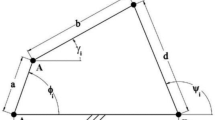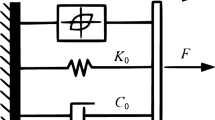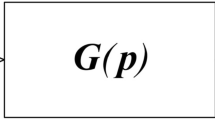Abstract
This paper deals with the problem of parameter optimization of the motion control mechanism of the hatch door of ARJ21-700, a regional airliner of China. Motion improvement of the hatch door is implemented by two kinds of passive designs. Firstly, a single-layer optimization model for trajectory modification is developed to find the optimum size of the key parts of the control mechanism. Secondly, a novel nested bi-level optimization model is presented for the design of the size tolerance limits of the selected parts. The design objective is minimization of the total extremum deviation of the motion trajectory of the objective point of the hatch door, where the extremum deviation is obtained by solution of the inner-level size optimization problem for the fixed size tolerance limits. The optimization models for motion control of the hatch door mechanism are solved using the response surface method. Numerical examples show that the precision of the real running trajectory of the objective point of the hatch door mechanism may be improved effectively by using the methods presented. A home-made multi-body dynamics solver (THUSOLVER) and the corresponding optimization software have been developed to implement the above tasks.











Similar content being viewed by others
References
Anderson KS, Hsu Y (2004) Order-(n + m) direct differentiation determination of design sensitivity for constrained multibody dynamic systems. Struct Multidiscip Optim 26(3–4):171–182
Avilés R, Vallejo J, Ajuria G, Agirrebeitia J (2000) Second-order methods for the optimum synthesis of multibody systems. Struct Multidiscip Optim 19(3):192–203
Bestle D, Eberhard P (1992) Analyzing and optimizing multibody systems. Mech Struct Mach 20(1):67–92
Bianch G, Schiehlen W (1986) Dynamics of multibody system. Springer, Berlin
Box GEP, Wilson KB (1951) On the experimental attainment of optimum conditions. J R Stat Soc Ser B Stat Methodol 13(1):1–45
Chun HG, Kwon SJ, Tak T (2008) Multibody approach for tolerance analysis and optimization of mechanical systems. J Mech Sci Technol 22(2):276–286
Collard JF, Fisette P, Duysinx P (2005) Contribution to the optimization of closed-loop multibody systems: Application to parallel manipulators. Multibody Syst Dyn 13(1):69–84
Connelly JD, Huston RL (1994a) The dynamics of flexible multibody systems - a finite segment approach.1. Theoretical aspects. Comput Struct 50(2):255–258
Connelly JD, Huston RL (1994b) The dynamics of flexible multibody systems - a finite segment approach.2. Example problems. Comput Struct 50(2):259–262
Datoussaid S, Verlinden O, Conti C (2001) Comparison of the use of GAs and ESs for the optimization of multibody systems. 15th European Simulation Multiconference, Prague, Tchequie, 6–9 June: 461–465.
Ding JY, Pan ZK, Chen LQ (2007) Second order adjoint sensitivity analysis of multibody systems described by differential-algebraic equations. Multibody Syst Dyn 18(4):599–617
Ding JY, Pan ZK, Chen LQ (2008) Second-order sensitivity analysis of multibody systems described by differential/algebraic equations: adjoint variable approach. Int J Comput Math 85(6):899–913
Eberhard P, Schiehlen W, Bestle D (1999) Some advantages of stochastic methods in multicriteria optimization of multibody systems. Arch Appl Mech 69(8):543–554
Erkaya S, Uzmay I (2009) Optimization of transmission angle for slider-crank mechanism with joint clearances. Struct Multidiscip Optim 37(5):493–508
Forsberg J, Nilsson L (2005) On polynomial response surfaces and Kriging for use in structural optimization of crashworthiness. Struct Multidiscip Optim 29(3):232–243
Gerdts M (2004) Parameter optimization in mechanical multibody systems and linearized Runge–Kutta methods. Prog Ind Math ECMI 5:121–126
Goncalves JPC, Ambrosio JAC (2003) Optimization of vehicle suspension systems for improved comfort of road vehicles using flexible multibody dynamics. Nonlinear Dyn 34(1–2):113–131
Gustafsson E, Strömberg N (2008) Shape optimization of castings by using successive response surface methodology. Struct Multidiscip Optim 35(1):11–28
Haddadpour H, Firouz RD, Fotouhi MM (2008) Equilibrium analysis of multibody dynamic systems using genetic algorithm in comparison with constrained and unconstrained optimization techniques. Struct Multidiscip Optim 36(4):381–391
Haug EJ, Wehage R, Barman NC (1981) Design sensitivity analysis of planar mechanism and machine dynamics. J Mech Des Trans ASME 103(3):560–570
Haug EJ, Ehle PE (1982) 2nd-order design sensitivity analysis of mechanical system dynamics. Int J Numer Methods Eng 18(11):1699–1717
Haug EJ, Wehage RA, Mani NK (1984) Design sensitivity analysis of large-scale constrained dynamic mechanical systems. J Mech Transm Autom Des Trans ASME 106(2):156–162
Hay AM, Snyman JA (2005) A multi-level optimization methodology for determining the dextrous workspaces of planar parallel manipulators. Struct Multidiscip Optim 30(6):422–427
Hong EP, You BJ, Kim CH, Park GJ (2010) Optimization of flexible components of multibody systems via equivalent static loads. Struct Multidiscip Optim 40(1–6):549–562
Hsu Y, Anderson KS (2002) Recursive sensitivity analysis for constrained multi-rigid-body dynamic systems design optimization. Struct Multidiscip Optim 24(4):312–324
Ider SK, Oral S (1996) Optimum design of flexible multibody systems with dynamic behavior constraints. Eur J Mech sSolids 15(2):351–359
Kim SS, Haug EJ (1988) A recursive formulation for flexible multibody dynamics,1. Open-loop systems. Comput Methods Appl Mech Eng 71(3):293–314
Kim SS, Haug EJ (1989) A recursive formulation for flexible multibody dynamics.2. Closed-loop systems. Comput Methods Appl Mech Eng 74(3):251–269
Kwon YS, Copeland G, Park NG (2005) A multibody dynamic model for escalator handrail systems and its application to dynamic characteristics. Multibody Syst Dyn 13(2):253–266
Likins PW (1972) Finite element appendage equations for hybrid coordinate dynamic analysis. J Solids Struct 8(5):709–731
Liu XJ (1996) Sensitivity analysis of constrained flexible multibody systems with stability considerations. Mech Mach Theory 31(7):859–863
Minnaar RJ, Tortorelli DA, Snyman JA (2001) On nonassembly in the optimal dimensional synthesis of planar mechanisms. Struct Multidiscip Optim 21(5):345–354
Mukherjee RM, Bhalerao KD, Anderson KS (2008) A divide-and-conquer direct differentiation approach for multibody system sensitivity analysis. Struct Multidiscip Optim 35(5):413–429
Ohkami Y, Likins PW (1979) Eigenvalues and eigenvectors for hybrid coordinate equations of motion for flexible spacecraft. Celest Mech 19(4):359–390
Panayi AP, Diaz AR, Schock HJ (2009) On the optimization of piston skirt profiles using a pseudo-adaptive response surface method. Struct Multidiscip Optim 38(3):317–330
Prebil I, Krašna S, Ciglaric I (2002) Synthesis of four-bar mechanism in a hydraulic support using a global optimization algorithm. Struct Multidiscip Optim 24(3):246–251
Samin JC, Bruls O, Collard JF et al (2007) Multiphysics modeling and optimization of mechatronic multibody systems. Multibody Syst Dyn 18(3):345–373
Schulz M, Brauchli H (2000) Two methods of sensitivity analysis for multibody systems with collisions. Mech Mach Theory 35(10):1345–1365
Sigmund O (1997) On the design of compliant mechanisms using topology optimization. Mech Struct Mach 25(4):493–524
Tromme E, Brüls O, Emonds J, Bruyneel M, Virlez G, Duysinx P (2013) Discussion on the optimization problem formulation of flexible components in multibody systems. Struct Multidiscip Optim 48(6):1189–1206
Venter G, Haftka RT (1999) Using response surface approximations in fuzzy set based design optimization. Struct Optim 18(4):218–227
Xiang Y, Arora JS, Abdel K (2009) Optimization-based motion prediction of mechanical systems: sensitivity analysis. Struct Multidiscip Optim 37(6):595–608
Acknowledgment
Projects (11372154, 90816025) supported by National Natural Science Foundation of China, and the Commercial Aircraft Corporation of China (COMAC).
Author information
Authors and Affiliations
Corresponding author
Rights and permissions
About this article
Cite this article
Du, J., Huang, Z. & Yang, R. Optimization of the motion control mechanism of the hatch door of airliner. Struct Multidisc Optim 51, 1173–1186 (2015). https://doi.org/10.1007/s00158-014-1191-y
Received:
Revised:
Accepted:
Published:
Issue Date:
DOI: https://doi.org/10.1007/s00158-014-1191-y




